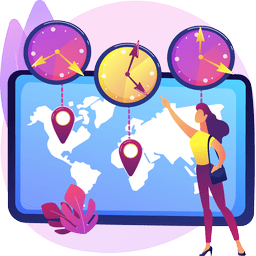What the tool does
- Enumerates all time zones from the IANA database (e.g.,
America/New_York,Europe/Stockholm,Asia/Tokyo). - Shows real-time UTC offsets including Daylight Saving Time where applicable.
- Calculates differences vs. a selected reference zone so you see how many hours ahead/behind each zone is.
- Highlights “My Time Zone” so you can sanity-check local time and offsets.
- Search and filter by region or city to jump straight to the zones you need.
Why it matters
Scheduling across regions is error-prone due to DST changes, hemispheric seasons, and shifting regional policies. This tool centralizes the live offsets and computes differences relative to a single anchor zone, removing guesswork and spreadsheet hacks.
How to use it
- Pick a reference time zone from the dropdown. This becomes your baseline.
- Review the table of all time zones. Each row shows zone name, current local time, UTC offset, and difference vs. your selected zone.
- Use search to find a specific city/region and confirm its current difference.
- Adjust the reference to model alternative working hours or host-time assumptions.
Common use cases
- Global meetings: pick a fair slot across teams in AMER, EMEA, and APAC.
- Release planning: verify “midnight UTC” or “noon PST” equivalents worldwide.
- Customer support: map on-call rotations to local business hours.
- Marketing: schedule emails or ads to hit morning windows by region.
- Ops & SRE: time maintenance windows to minimize user impact.
Key features
- IANA accuracy: zones follow canonical IDs and offsets.
- DST-aware: offsets reflect current rules in effect now.
- Local detection: the tool displays your browser’s time zone for quick comparison.
- Fast filtering: find zones by typing part of a region or city name.
Tips for precise scheduling
- Anchor on a single zone (e.g., product team HQ) to avoid cascading mistakes.
- Confirm near DST boundaries: offsets shift on different dates per region.
- Communicate in absolute time: include
YYYY-MM-DDandHH:MMwith time zone label. - Add a calendar hold after choosing a slot to prevent drift or double-booking.
FAQ
- Does it account for Daylight Saving Time?
- Yes. Current offsets incorporate DST when active in that zone.
- What time zones are listed?
- All standard IANA zones (e.g.,
Region/Cityformat) commonly used by operating systems and browsers. - Why does “My Time Zone” differ from my company calendar?
- Browsers read your device’s configured zone. If your calendar uses a different profile/region, align both to the same zone.
- Can I plan for future dates?
- This view focuses on current differences. For future scheduling near DST switches, verify again closer to the date.
Best practices for global teams
- Rotate meeting times to share inconvenience across regions.
- Publish a time-zone reference in docs using IANA IDs to prevent ambiguity.
- Send invites with ICS so attendees see correct local times in their calendars.
